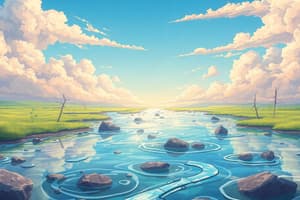Podcast
Questions and Answers
What are some examples of natural sources of air pollution mentioned in the text?
What are some examples of natural sources of air pollution mentioned in the text?
- Power plants and industrial facilities
- Volcanic eruptions and dust storms (correct)
- Transportation emissions and waste incinerators
- Livestock farming and agriculture
How do contaminants in water affect humans?
How do contaminants in water affect humans?
- They result in fish population decline and disrupt species' reproductive cycles
- They lead to reduced tourism revenue and fishing income
- They have been linked to neurological disorders
- They can cause skin rashes and respiratory problems (correct)
Which water treatment method uses living organisms to break down organic material in wastewater?
Which water treatment method uses living organisms to break down organic material in wastewater?
- Physical filtration with sand and gravel filters
- Biological treatment with bacteria, fungi, and protozoa (correct)
- Reverse Osmosis under high pressure
- Chemical coagulation with alum or iron salts
What is one significant impact of air pollution mentioned in the text?
What is one significant impact of air pollution mentioned in the text?
Which of the following activities contributes significantly to air pollution according to the text?
Which of the following activities contributes significantly to air pollution according to the text?
What is the primary difference between point source pollution and nonpoint source pollution?
What is the primary difference between point source pollution and nonpoint source pollution?
Which of the following is NOT a common cause of water pollution?
Which of the following is NOT a common cause of water pollution?
How do industrial operations contribute to water pollution?
How do industrial operations contribute to water pollution?
What are some effects of water pollution on the environment?
What are some effects of water pollution on the environment?
Which of the following is a common source of air pollution according to the text?
Which of the following is a common source of air pollution according to the text?
Flashcards are hidden until you start studying
Study Notes
Pollution of Water and Air
Water and air play vital roles in sustaining life on Earth. However, human activities have introduced pollutants into these essential resources, leading to significant environmental degradation. This article will discuss the sources of water and air pollution, its effects, and the various ways we treat and purify them to ensure cleaner environments.
Sources of Water Pollution
The primary sources of water pollution can broadly be classified into two categories: point source pollution and nonpoint source pollution. Point source pollution occurs when waste is discharged directly from a specific location such as a factory, sewage plant, or agricultural runoff. Nonpoint source pollution, on the other hand, is more diffuse and results from rainwater percolating through soil contaminated by pesticides, oil spills, fertilizers, industrial chemicals, and urban runoff. Some common causes of water pollution include:
- Agricultural practices that involve excessive use of insecticides and fertilizers.
- Industrial operations that release toxic materials like heavy metals, oils, greases, detergents, solvents, and acids into water bodies.
- Urban development resulting in increased stormwater runoff containing sediments, nutrients, pathogens, hydrocarbon compounds, and debris.
- Domestic wastewater carrying organic matter, suspended solids, bacteria, viruses, and parasites from households.
Effects of Water Pollution
Water pollution has severe consequences on ecosystems and human health. When aquatic animals consume contaminants, they can pass it up the food chain to humans who eat seafood. Ingesting large amounts of mercury, for example, has been linked to neurological disorders. Similarly, exposure to certain bacteria, algae, and viruses can cause gastrointestinal upset, respiratory problems, skin rashes, and even death. Additionally, polluted water affects fish populations, disrupts the reproductive cycles of many species, and leads to widespread economic losses due to reduced tourism revenue and fishing income.
Methods of Water Treatment
To mitigate the impact of water pollution, several techniques are employed globally. These include physical, chemical, biological, and mechanical processes designed to remove impurities and render the water suitable for consumption or discharge without causing harm. Examples of some widely used treatment methods are:
- Physical filtration involving sand, gravel, or anthracite filters which trap particles larger than their pore size to produce clear water.
- Chemical coagulation using alum or iron salts, followed by flocculation with polymers, to form larger clumps called floc, which settle out under gravity.
- Biological treatment utilizing living organisms like bacteria, fungi, and protozoa to break down dissolved organic material present in wastewater.
- Reverse Osmosis wherein high pressure forces water across a semipermeable membrane, retaining most of the contaminants behind.
Sources of Air Pollution
Air pollution arises from both natural and human-induced factors. Natural sources include volcanic eruptions, forest fires, dust storms, and microorganisms such as mold and mildew. Human activities contribute significantly to air pollution via combustion engines, power plants, industrial facilities, agriculture, and residential heating systems. Common sources of air pollution include:
- Emissions from transportation, including cars, trucks, buses, ships, trains, and planes.
- Waste incinerators burning hazardous household wastes such as batteries, paint cans, and electronics.
- Power generation facilities firing coal, petroleum products, and biomass fuels.
- Agriculture, especially livestock farming where manure releases methane, nitrous oxide, and ammonia.
Effects of Air Pollution
When pollutants enter our atmosphere, they affect public health, climate change, and ecosystem balance. Some key impacts of air pollution are:
- Respiratory diseases caused by long-term exposure to particulate matter, ground level ozone or other air pollutants.
- Acid rain forming from sulfur dioxide and nitrogen oxides emitted during fossil fuel combustion, deteriorating freshwater lakes, forests, historic buildings, and monuments.
- Climate change triggered by greenhouse gas emissions exacerbating global warming.
Mitigating Air Pollution
Reducing air pollution requires collective efforts aimed at curbing the emission of pollutants while promoting sustainable energy alternatives. Measures include improving vehicle efficiency, increasing renewable energy usage, investing in public transport infrastructure, encouraging walking, biking, and carpooling, and incentivizing industry to switch to clean technologies. Governments worldwide implement policies such as emission standards, tax structures, and subsidy programs to stimulate proactive actions among industries and individuals alike.
In conclusion, understanding the sources and effects of water and air pollution is crucial for developing effective strategies to combat this growing problem. By implementing proper water treatment methods and addressing major contributors to air pollution, we can work towards preserving our precious water and air resources for generations to come.
Studying That Suits You
Use AI to generate personalized quizzes and flashcards to suit your learning preferences.




